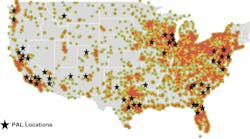WASHINGTON, D.C. – Despite rising freight rates, the costs of logistics as a percentage of gross domestics product (GDP) fell for the third year in a row, according to the annual ‘State of Logistics Report’ unveiled here at the National Press Club.
However, the uncertainty surrounding the costs of new and impending security regulations and the rapid escalation of diesel prices worry Rosalyn Wilson, the report’s author who figures supply chain costs may rise substantially in the near future.
“There’s no doubt in my mind that new [freight] security rules are going to add substantial costs to logistics networks in the U.S.,” said Wilson, a transportation consultant based in Sterling, VA. “The concern is there is no clear strategy yet as to what technology would be used and what data would be required to improve freight security.”
According to her report, the total cost of the U.S. business logistics system topped $936 billion in 2003 – an increase of $26 billion over 2002. Yet, due to the economic recovery underway in the U.S., logistics costs as a percent of GDP fell to 8.5% last year, compared to 8.7% in 2002 and 9.5% in 2001.
However, transportation costs are continuing to escalate. That’s putting a lot of upward pressure on logistics costs for shippers, said Wilson – though to the benefit of truckers.
“Trucking costs increased by $20 billion [totaling $482 billion] in 2003 compared to 2002,” she noted. “Increased demand for their services allowed larger [trucking] companies to be more selective in the freight they were carrying and to push through rate increases. Also, with shippers still constrained by a lack of options, the trucking industry is continuing to be able to push through surcharges to cover surging fuel costs.”


